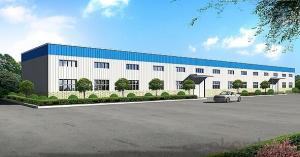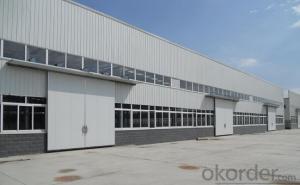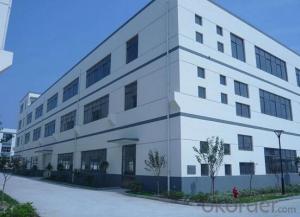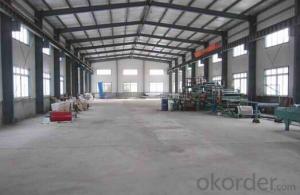prefab steel warehouse building
- Loading Port:
- China Main Port
- Payment Terms:
- TT OR LC
- Min Order Qty:
- -
- Supply Capability:
- -
OKorder Service Pledge
Quality Product, Order Online Tracking, Timely Delivery
OKorder Financial Service
Credit Rating, Credit Services, Credit Purchasing
You Might Also Like
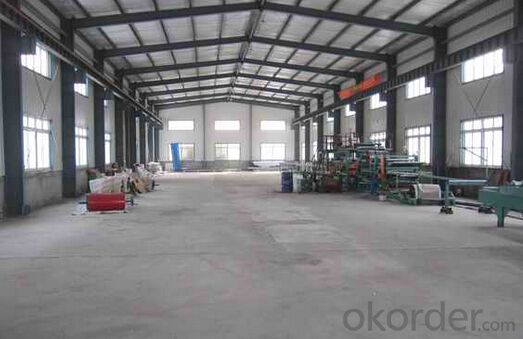
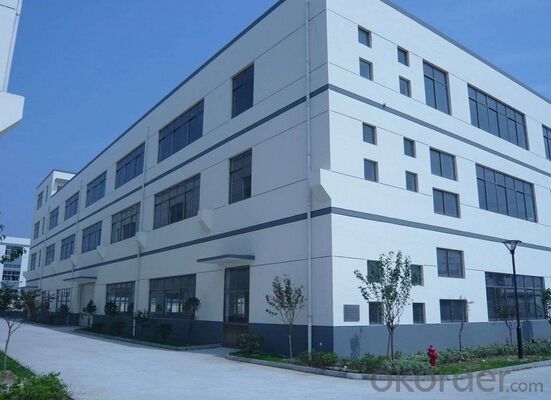
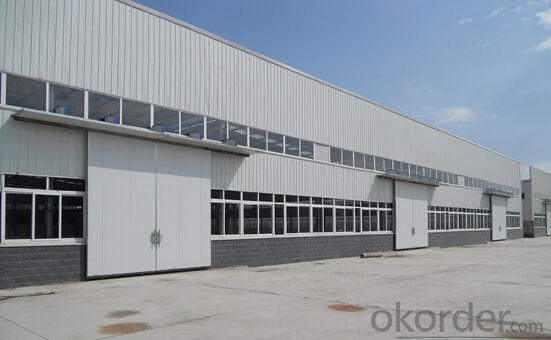

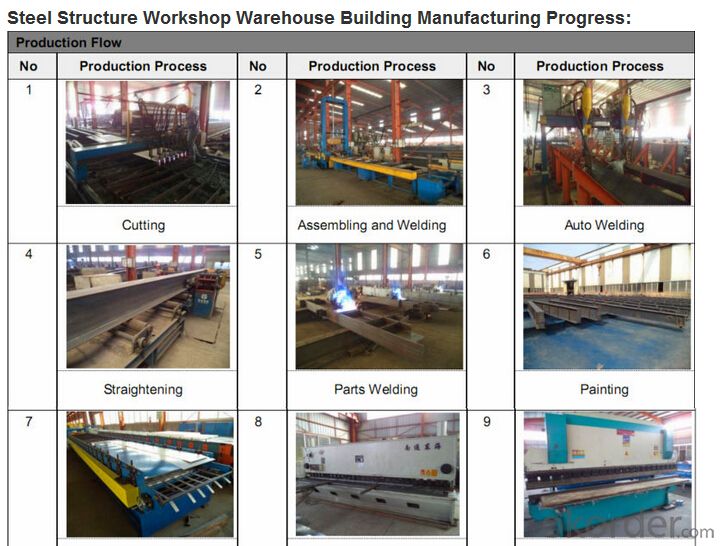
Specifications
steel structure warehouse/sheds/factory Specifications
Prefabricated House.
Repeat use and long life.
Anti-rust.low cost
| Material | C Purlin, H Beam, Sandwich panel, Hot Galvanised Steel, etc. |
| Features | 1. Firm and Artistic |
| 2. Durable for 30 years at least. | |
| 3. Reusale, and Easy to intall and dismantle: usually, one worker could install 20-30 square meters per day, six workers could work out 3K*10K houses in two days. | |
4. Extensive Applications: Warehouse, Plant, Exhibition Hall, Terminal Building, Stadium, Theater, Special-shaped Buildings. | |
| 5. Hot Galvanised… | |
| 6.Flexible composition: Doors and Windows could be installed at any positions,Separate Walls could be built at any transverse axis. Stairs could be outside Steel buildings. |
- Q:How are steel structures designed for different communication systems?
- Steel structures are designed for different communication systems by considering factors such as the weight and height requirements of the system, the structural integrity needed to support the equipment, and the accessibility for maintenance and installation. This involves analyzing the load capacity of the steel structure, selecting appropriate materials, and incorporating features like antenna mounts or cable management systems to accommodate the specific communication system's needs.
- Q:How do steel structures contribute to the overall cost-effectiveness of a building?
- Steel structures contribute to the overall cost-effectiveness of a building in several ways. Firstly, steel is a highly durable material with a long lifespan, which reduces the need for frequent repairs or replacements, saving money in the long run. Additionally, steel structures are easy and quick to construct, reducing labor costs and minimizing the overall construction time. Moreover, steel is a lightweight material, enabling smaller foundations and reducing the amount of excavation required, leading to cost savings. Lastly, steel is a recyclable material, making it environmentally friendly and potentially reducing disposal costs at the end of a building's life cycle.
- Q:What are the design considerations for steel canopies and outdoor seating areas?
- When designing steel canopies and outdoor seating areas, there are several key considerations that need to be taken into account. These considerations include: 1. Structural Integrity: Steel canopies and outdoor seating areas need to be built with a strong and stable structure to ensure they can withstand various weather conditions, such as heavy rain, snow, and strong winds. The design should be able to support the weight of the canopy itself, as well as any additional loads that may be placed on it, such as lighting fixtures or hanging plants. 2. Durability: Steel is chosen for its durability, but the design should also take into account the potential for corrosion or rust. Proper coatings or finishes can be applied to protect the steel from the elements and increase its lifespan. 3. Aesthetics: The design of the steel canopy and outdoor seating area should be visually appealing and complement the surrounding environment. Considerations such as shape, color, and style should be taken into account to ensure that the design fits seamlessly into its surroundings and enhances the overall aesthetic appeal of the space. 4. Functionality: The design should consider the intended use of the space. Outdoor seating areas should be comfortable and accommodating, with proper spacing and seating arrangements to accommodate different group sizes. Canopies should provide adequate shade and protection from the elements, while also allowing for proper ventilation and airflow. 5. Accessibility: It is important to ensure that the design of the steel canopy and outdoor seating area is accessible to all individuals, including those with disabilities. This may involve incorporating features such as ramps, handrails, and accessible seating options to comply with accessibility guidelines and regulations. 6. Maintenance: The design should take into account the ease of maintenance and cleaning. Steel canopies and outdoor seating areas should be designed in a way that allows for easy access and cleaning of all components, including the canopy itself, seating surfaces, and any integrated features or accessories. In conclusion, when designing steel canopies and outdoor seating areas, it is crucial to consider structural integrity, durability, aesthetics, functionality, accessibility, and maintenance. By carefully addressing these design considerations, a well-designed and functional outdoor space can be created, providing a comfortable and visually appealing area for people to relax and enjoy.
- Q:How is steel used in industrial structures?
- Due to its exceptional strength, durability, and versatility, steel finds widespread use in industrial structures. It serves as a primary material in the construction of various industrial buildings, including factories, warehouses, power plants, and refineries. The strength-to-weight ratio of steel is one of the significant reasons for its preference in industrial structures. With its high tensile strength, steel can endure heavy loads and stresses, making it suitable for constructing spacious areas and supporting heavy machinery and equipment. Furthermore, steel's durability and resistance to corrosion make it an ideal choice for industrial environments. Industrial structures often face harsh conditions, such as extreme temperatures, humidity, and chemical exposure. Steel's inherent resistance to rust and deterioration ensures the building's long-lasting nature and structural integrity. Another advantage of steel lies in its design versatility. It can be effortlessly molded and fabricated into different shapes and sizes, facilitating flexible and efficient construction. Whether in the form of beams, columns, trusses, or frames, steel provides structural stability and support. Moreover, steel proves to be a sustainable option for industrial structures. It is a recyclable material, reducing waste and minimizing environmental impact. The use of recycled steel in construction also helps in the conservation of natural resources. In conclusion, steel plays a crucial role in industrial structures due to its strength, durability, versatility, and sustainability. Its unmatched properties make it a reliable and cost-effective choice for constructing safe and robust industrial buildings capable of withstanding the demands of modern industries.
- Q:How are steel structures designed to be resistant to internal and external forces?
- Steel structures are designed to be resistant to internal and external forces through a combination of factors. Firstly, the material itself, steel, has high tensile strength, which allows it to withstand large amounts of force without breaking or deforming. Additionally, the design of steel structures incorporates various techniques such as bracing, cross-section shapes, and connection details to distribute and resist forces efficiently. These design considerations ensure that steel structures can withstand internal forces like gravity and external forces like wind, earthquakes, and snow loads, making them highly durable and resistant.
- Q:What are the economic considerations of using steel structures?
- There are several economic considerations involved in using steel structures. Firstly, steel is a durable and long-lasting material that requires minimal maintenance, reducing the costs of repairs and replacements over time. Additionally, steel structures can be prefabricated, which accelerates construction timelines and reduces labor costs. Steel is also recyclable, allowing for cost savings through material reuse. Moreover, steel structures offer design flexibility, enabling efficient use of space and optimizing construction costs. Lastly, steel's high strength-to-weight ratio allows for lighter foundations and structural components, resulting in potential savings in construction materials and transportation costs.
- Q:What are the considerations for steel structure design in desert environments?
- When designing steel structures in desert environments, there are several crucial considerations that need to be taken into account. These considerations are essential for ensuring the longevity, safety, and efficiency of the structure in such extreme environmental conditions. 1. Temperature Extremes: Desert environments are characterized by extreme temperature fluctuations, with scorching heat during the day and significant temperature drops at night. These temperature variations can cause thermal expansion and contraction of steel, leading to potential structural issues. Therefore, designers must carefully account for these temperature changes by incorporating appropriate expansion joints, thermal insulation, and selecting steel grades with high resistance to thermal stress. 2. Corrosion Protection: Desert environments often have low humidity levels, which can create an arid and corrosive atmosphere. Additionally, the presence of sand and dust particles can accelerate the corrosion process. To combat this, special attention should be given to corrosion protection measures such as galvanizing, painting, or the use of weather-resistant steel grades. Regular maintenance and inspections are also crucial to identify and address any signs of corrosion early on. 3. Wind and Sandstorms: Desert regions are prone to strong winds and occasional sandstorms, which can exert significant forces on steel structures. The design should incorporate wind load calculations and consider the local wind patterns to ensure structural stability. Additionally, measures should be taken to prevent sand and dust ingress, such as sealing gaps, using fine mesh screens, or incorporating ventilation systems with filters to protect sensitive equipment and prevent structural damage. 4. Foundation Design: The desert soil composition can vary greatly, ranging from loose sand to hard-packed clay. The foundation design should consider the specific soil conditions to ensure proper load distribution and stability. Soils with low bearing capacity may require deep foundations or techniques like soil stabilization to ensure the structure's integrity. 5. Solar Radiation: Desert environments receive intense solar radiation, which can lead to excessive heat gain in the structure. To minimize this, designers should incorporate shading devices, reflective coatings, or insulation to reduce the energy consumption required for cooling and maintain a comfortable indoor environment. 6. Water Availability: Water scarcity is a common challenge in desert environments. Therefore, the design should prioritize water conservation measures, such as rainwater harvesting systems, efficient plumbing fixtures, and landscaping techniques that minimize water usage. 7. Sustainability: Desert regions often have fragile ecosystems, and sustainable design practices should be prioritized to minimize the environmental impact. This can include using recycled or locally sourced materials, optimizing energy efficiency through passive design strategies, and incorporating renewable energy sources such as solar panels. In conclusion, designing steel structures in desert environments requires careful consideration of temperature fluctuations, corrosion protection, wind and sandstorms, foundation design, solar radiation, water availability, and sustainability. By addressing these considerations, engineers can ensure the durability, safety, and efficiency of structures in these challenging environments.
- Q:What are the design considerations for steel theaters and auditoriums?
- When designing steel theaters and auditoriums, it is crucial to prioritize structural integrity. The steel structures must be able to withstand the loads imposed by the building and its occupants, as well as any additional loads from equipment, stage rigging, and lighting. The main goal is to ensure the stability and safety of everyone inside. In theaters and auditoriums, acoustics play a vital role. The design should incorporate sound-absorbing materials, such as acoustic panels, to minimize sound reflections and achieve optimal sound quality. It is important to carefully consider the placement of speakers, microphones, and other audio equipment to ensure clear and balanced sound distribution throughout the space. Fire safety is a critical aspect of any building design, including theaters and auditoriums. While steel structures can have fire-resistant properties, additional fire safety measures must be implemented. This may include the use of fire-rated doors, fire suppression systems, and adequate emergency exits to ensure the safety of occupants in case of a fire emergency. When it comes to theater and auditorium design, accessibility is essential. The layout should provide accessible pathways, ramps, and seating areas for individuals with disabilities. Special attention should be given to the placement of wheelchair-accessible seating, accessible restrooms, and sufficient space for maneuverability. Aesthetic appeal also holds great importance in theater and auditorium design. The use of steel can create a contemporary and industrial aesthetic, allowing designers to showcase the steel structure as an architectural feature. This can be achieved by incorporating exposed beams or trusses. Furthermore, the overall ambiance, lighting, and color schemes should be carefully considered to create an immersive and visually appealing experience for the audience. In conclusion, the design considerations for steel theaters and auditoriums encompass structural integrity, acoustics, fire safety, accessibility, and aesthetic appeal. By focusing on these aspects, a safe, functional, and visually pleasing environment can be created for both performers and audience members.
- Q:What are the applications of steel structures in industrial buildings?
- Steel structures have numerous applications in industrial buildings due to their exceptional strength, durability, and versatility. Some key applications include the construction of warehouses, factories, power plants, and distribution centers. Steel structures provide a cost-effective solution for large clear-span spaces, allowing for flexible floor plans and efficient utilization of space. Additionally, steel's high load-bearing capacity makes it ideal for supporting heavy machinery and equipment. The inherent fire-resistant properties of steel enhance safety in industrial settings. Overall, steel structures offer a reliable and efficient solution for constructing robust and functional industrial buildings.
- Q:How are steel structures designed to accommodate architectural features?
- Steel structures are designed to accommodate architectural features through careful planning and engineering. Architects work closely with structural engineers to integrate their design elements into the steel framework. This is achieved by incorporating additional supports, connections, and bracing to ensure the structural integrity of the building while accommodating features like large windows, cantilevers, or unique shapes. The steel framework is designed to provide the necessary strength and flexibility to support these architectural features, resulting in a harmonious and functional design.
1. Manufacturer Overview |
|
|---|---|
| Location | |
| Year Established | |
| Annual Output Value | |
| Main Markets | |
| Company Certifications | |
2. Manufacturer Certificates |
|
|---|---|
| a) Certification Name | |
| Range | |
| Reference | |
| Validity Period | |
3. Manufacturer Capability |
|
|---|---|
| a)Trade Capacity | |
| Nearest Port | |
| Export Percentage | |
| No.of Employees in Trade Department | |
| Language Spoken: | |
| b)Factory Information | |
| Factory Size: | |
| No. of Production Lines | |
| Contract Manufacturing | |
| Product Price Range | |
Send your message to us
prefab steel warehouse building
- Loading Port:
- China Main Port
- Payment Terms:
- TT OR LC
- Min Order Qty:
- -
- Supply Capability:
- -
OKorder Service Pledge
Quality Product, Order Online Tracking, Timely Delivery
OKorder Financial Service
Credit Rating, Credit Services, Credit Purchasing
Similar products
New products
Hot products
Hot Searches
Related keywords
